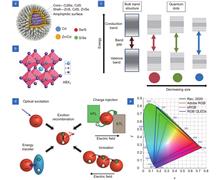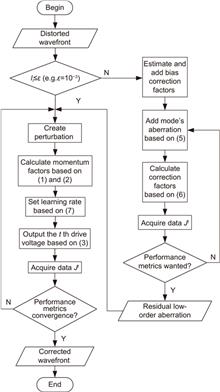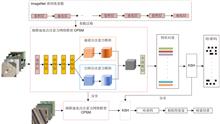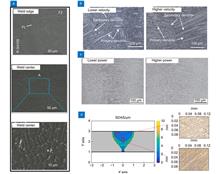 View fulltext
View fulltext
Overview: Quantum dot is a kind of semiconductor nanocrystal with a quantum confinement effect. Recently, quantum dots have been applied for display due to their advantages including high photoluminescent efficiency, tunable emission wavelength, narrow emission spectrum, and low-cost solution process. In this paper, we focus on the application of quantum dots in microdisplay. With the rising near-eye display demands such as AR/VR, the realization of full color, high efficiency, and high luminance microdisplay attracts many attentions. However, the realization of the target microdisplay is difficult due to the high-cost mass transfer technology in micro-LED and the insufficient luminance in micro-OLED. Here, the photoluminescent (PL) and electroluminescent (EL) quantum dots can provide new routes for microdisplay. For PL, quantum dots can work as color conversion material for micro-LED. The multiple-time mass transfer can be avoided with the combination of red and green quantum dots and blue micro-LED. Meanwhile, the color gamut can be improved due to the narrow FWHM of quantum dot emission. For EL, RGB quantum dots can work as an emission layer in QLED, and the RGB micro-QLED can be applied for microdisplay directly with a compact and high-efficiency system. Compared with OLED, the QLED can realize higher luminance due to the inherent stability of the inorganic quantum dot, which is more suitable for AR display requiring high luminance. The patterning of quantum dot layer is the first step for the application in microdisplay. For both PL and EL applications, a high pixel density, high pixel uniformity, high pixel consistency, and low-cost patterning method is required. For the quantum dot color conversion layer in PL application, a high optical density is required for the sufficient absorption of the blue light. For the quantum dot emission layer in EL application, the uniform and small roughness surface quantum dot layer is required with few damages to the quantum dots to ensure the good performance of QLED devices. There are several patterning methods have been reported for quantum dots including inkjet printing, photolithography, transfer printing, electrophoretic deposition, in situ fabrication, and optical micro cavity. However, it is still challenging to find a perfect patterning method for the quantum dot layer. For PL application, the stability of quantum dot under long time high-intensity blue light excitation is a big problem due to the photoinduced quenching and oxidation. For EL application, compared with red and green QLED, the peak luminance, efficiency, and lifetime of blue QLED needs to be further improved by optimizing the blue quantum dots and device structure to satisfy the requirement of the display application.The quantum dot is a kind of semiconductor nanocrystal with quantum confinement effect, which attracts a lot of attention due to the excellent optoelectronic properties and has been widely used in the display area. The quantum dot become one of the core materials of display with several advantages including the high luminance efficiency, tunable emission wavelength, narrow FWHM and low-cost solution fabrication. Micro display technology is applied in the near eye display scenario with small effective display area (diagonal < 1 inch). Recently, the rising of VR/AR application scenarios require micro display technology with higher luminance, higher pixel density, and full color display. In this paper, we review the current progress of the quantum dot in micro display from photoluminescence and electroluminescence technique routes. The chances and challenges of the quantum dot in micro display are also summarized.
The Lukosz pre-correction modal algorithm can correct low-order aberrations of wavefront distortion and narrow the search range of iterative algorithms. The adaptive cosine-decay stochastic parallel gradient descent (AcSPGD) algorithm can compensate for high-order aberrations of wavefront distortion and improve the correction accuracy of iterative algorithms. In this paper, a new hybrid modal algorithm based on the pre-correction model and AcSPGD algorithm is applied to correct wavefront distortion in wavefront sensorless adaptive optics, and the feasibility of the optimization algorithm is also verified by the experiments. Experimental results show that the correction speed of the hybrid modal algorithm is two times faster than the commonly used stochastic parallel gradient descent (SPGD) algorithm, and the correction accuracy of the hybrid modal algorithm is better than the traditional Lukosz modal algorithm. Applied to wavefront sensorless adaptive optics, the optimization algorithm effectively reduces the phase fluctuation of the wavefront and improves the far-field Strehl ratio, which thus improves the signal-to-noise ratio of the atmospheric laser communication system by 2.9 dB, reduces the bit error rate to 10?6, and improves the communication performance of the free-space optical communication system. The hybrid modal algorithm has great reference and application value.The Lukosz pre-correction modal algorithm can correct low-order aberrations of wavefront distortion and narrow the search range of iterative algorithms. The adaptive cosine-decay stochastic parallel gradient descent (AcSPGD) algorithm can compensate for high-order aberrations of wavefront distortion and improve the correction accuracy of iterative algorithms. In this paper, a new hybrid modal algorithm based on the pre-correction model and AcSPGD algorithm is applied to correct wavefront distortion in wavefront sensorless adaptive optics, and the feasibility of the optimization algorithm is also verified by the experiments. Experimental results show that the correction speed of the hybrid modal algorithm is two times faster than the commonly used stochastic parallel gradient descent (SPGD) algorithm, and the correction accuracy of the hybrid modal algorithm is better than the traditional Lukosz modal algorithm. Applied to wavefront sensorless adaptive optics, the optimization algorithm effectively reduces the phase fluctuation of the wavefront and improves the far-field Strehl ratio (SR), thus improving the communication performance of the free-space optical communication (FSO) system.
Overview: With the development of remote sensing satellite technology and the expansion of the market in remote sensing images (RSIs), content-based remote sensing image retrieval (RSIR) plays an irreplaceable role in many fields, such as economic and social development, resource and environmental monitoring, and urban life management. However, there are complex content and rich background information in the high-resolution remote sensing images, whose features extracted by convolutional neural networks are difficult to effectively express the salient information of the RSIs. For this problem in high-resolution RSIR, a self-attention mechanism based on cascading pooling is proposed to enhance the feature expression of convolutional neural networks. Firstly, a cascade pooling self-attention module is designed. Cascade pooling uses max pooling based on a small region, and then adopts average pooling based on the max pooled feature map. Compared with traditional global pooling, cascade pooling combines the advantages of max pooling and average pooling, which not only pays attention to the salient information of the RSIs, but also retains crucial detailed information. The cascade pooling is employed in the self-attention module, which includes spatial self-attention and channel self-attention. The spatial self-attention combines self-attention and spatial attention based on location correlation, which enhances specific object regions of interest through spatial weights and weakens irrelevant background regions, to strengthen the ability of spatial feature description. The channel self-attention combines self-attention and content correlation-based channel attention, which assigns weights to different channels by linking contextual information. Each channel can be regarded as the response of one class of features, and more weights are assigned to the features with large contributions, thereby the ability to discriminate the salient features of the channel is enhanced. The cascade pooling self-attention module can learn crucial salient features of the RSIs based on the establishment of semantic dependencies. After that, the cascade pooled self-attention module is embedded into the convolutional neural networks to extract features and optimize features. Finally, in order to further increase the retrieval efficiency, supervised Hashing with kernels is applied to reduce the dimensionality of features, and then the obtained low-dimensional hash code is utilized in the RSIR. Experiments are conducted on the UC Merced, AID and NWPU-RESISC45 datasets, the mean average precisions reach 98.23%, 94.96% and 94.53% respectively. The results show that compared with the existing retrieval methods, the proposed method improves the retrieval accuracy effectively. Therefore, cascade pooling self-attention and supervised hashing with kernels optimize features from two aspects of network structure and feature compression respectively, which enhances the feature representation and improves retrieval performance.In high-resolution remote sensing image retrieval, due to the complex image content and rich detailed information, it is difficult for the features extracted by a convolutional neural network to effectively express the salient information of the image. In response to this issue, a self-attention module based on cascade pooling is proposed to improve the feature representation of convolutional neural networks. Firstly, a cascade pooling self-attention module is designed, and the self-attention module can learn key salient features of images on the basis of establishing semantic dependencies. Cascade pooling uses max pooling based on a small region, and then adopts average pooling based on the max pooled feature map. The cascade pooling is exploited in the self-attention module, which can keep important details of the image while paying attention to the salient information of the image, thereby enhancing feature discrimination. After that, the cascade pooled self-attention module is embedded into the convolutional neural network for feature optimization and extraction. Finally, in order to further improve the retrieval efficiency, supervised hashing with kernels is applied to reduce the dimensionality of features, and then the obtained low-dimensional hash code is utilized for remote sensing image retrieval. The experimental results on the UC Merced, AID and NWPU-RESISC45 data sets show that the proposed method can improve the retrieval performance effectively.
Overview: With the rapid development of aerospace, energy power, petrochemical, and other fields, nickel-based alloy sheet welding technology has become one of the key factors determining the performance of core components. The welding of nickel base alloy sheet is sensitive to the heat input, and it is easy to cause element segregation and brittle phase precipitation, which will reduce the weld performance and produce welding deformation. This paper introduces the research progress of laser welding technology of nickel base alloy sheet, and summarizes the evolution of weld microstructure, changes of mechanical properties and corrosion resistance, and the rules of welding deformation under two kinds of welding technologies including laser autogenous welding and laser welding with filler wire of nickel base alloy sheet. The research of the autogenous laser welding process focuses on Ni-Cr and Ni-Cr-Mo alloys. The grain morphology and element segregation are analyzed, including refining microstructure and inhibiting the formation of precipitates, by means of adjusting the process parameters, using ultrasonic vibration, and using a low-temperature cooling process. The microhardness of the two kinds of alloy welds is better than that of base metal, because of the finer grains in the welds. Tensile strength at room temperature can reach about 90% of the base metal, but high-temperature tensile performance is comparable to the base metal. Ni-Cr alloy welded joints show good high-temperature plasticity. The relatively lower tensile strength of the welded joints is relative to the worse morphology of the weld surfaces. The fatigue properties and corrosion resistance of the Ni-Cr-Mo alloy welds are comparable to those of the base metal. The research of laser welding of nickel-based alloy sheets with filler wire focuses on the Ni-Cr-Mo alloy, and the grain morphology, element segregation, and its regulation are still the focuses of the research. The microhardness and room temperature tensile strength of the welded joints with filler wire are better than those of the base metal. The better room temperature tensile strength of the welded joints benefits from both the finer weld grains and the occurrence of the reinforcement. Corrosion tests show that the welded joints have comparable corrosion resistance to the base metal. Welding deformation of nickel-based alloy sheets includes shrinkage deformation, deflection, and angular deformation. Compare with the traditional arc welding process, laser welding shows lower heat input, and thus, it leads to smaller deformation. At present, the research of welding deformation of nickel-based alloy sheet mainly concentrates on the prediction of deformation through the finite element method and reducing deformation through process parameters adjustment, restraint intensity control, and utilizing auxiliary processes. Future research should focus on the prediction of weld microstructure and the propose of various adaptive control strategies for microstructure, mechanical properties and corrosion resistance by combining with advanced algorithms. Besides, developing new types of intelligent welding processes is also an important part.With the rapid development of aerospace, energy power, petrochemical, and other fields, nickel-based alloy sheet welding technology has become one of the key factors determining the performance of core components. The welding of nickel base alloy sheet is sensitive to the heat input, and it is easy to cause element segregation and brittle phase precipitation, which will reduce the weld performance and produce welding deformation. This paper introduces the research progress of laser welding technology of nickel base alloy sheet, and summarizes the evolution of weld microstructure, changes of mechanical properties and corrosion resistance, and the rules of welding deformation under two kinds of welding technologies including laser autogenous welding and laser welding with filler wire of nickel base alloy sheet. It is proposed that the prediction of weld microstructure should be considered in the future research, which should combine with advanced algorithms to propose the adaptive control strategy of microstructure, mechanical properties and corrosion resistance, developing a new intelligent welding process.
This paper designed a plasmonic refractive index sensor which consists of gold nano cones and a gold film with a SiO2 film as spacer-layer. The surface plasmon resonance modes in the composite structure are studied by using the Finite Difference Time Domain method. The composite structure can stimulate not only localized surface plasmon, but also propagating surface plasmon. The energy of the incident electromagnetic wave is partially coupled to the localized surface plasmon through a single gold nano cone, and partially coupled to the propagating surface plasmon through a grating of gold nano cone array. The reflection spectra of the composite structure are simulated in the refractive index range of 1.30 to 1.40. It is found that the resonance wavelength has a linear relationship with the refractive index of the analyte, and the reflectivity at the resonance is almost zero due to the strong resonance coupling between localized and propagating surface plasmon. In addition, the full width at half maximum of propagating surface plasmon resonance mode is very narrow when the geometric parameters of gold nano cone are optimized. The sensitivity and figure of merit reach 770 nm/RIU and 113 RIU?1 respectively, and it has good refractive index sensing performance. The designed composite structure is expected to be widely used in the field of biochemical detection.A surface plasmon resonance refractive index sensor based on the coupling structure of gold nano cones and a gold film with a SiO2 film as spacer-layer is designed. The surface plasmon resonance modes in the composite structure are studied by using the Finite Difference Time Domain method. The composite structure can stimulate not only localized surface plasmon, but also propagating surface plasmon. The energy of the incident electromagnetic wave is partially coupled to the localized surface plasmon through a single gold nano cone, and partially coupled to the propagating surface plasmon through a grating of gold nano cone array. The reflection spectra of the composite structure are simulated in the refractive index range of 1.30 to 1.40. It is found that the resonance wavelength has a linear relationship with the refractive index of the analyte, and the reflectivity at the resonance is almost zero due to the strong resonance coupling between localized and propagating surface plasmon. In addition, the full width at half maximum of propagating surface plasmon resonance mode is very narrow when the geometric parameters of gold nano cone are optimized. The sensitivity and figure of merit reach 770 nm/RIU and 113 RIU?1 respectively, and it has good refractive index sensing performance. The designed composite structure is expected to be widely used in the field of biochemical detection.
2) On the premise of taking an additional texture camera, marker points are added in the measured field, and the mapping relationship between the 3D point cloud and the 2D texture image can be obtained from the camera imaging model. To further get rid of the constraints of adding markers, an unconstrained free texture mapping method is proposed for objects with rich textures. The idea is to perform feature matching between the object images captured by the left and right cameras. According to the corresponding relationship between feature matching points and the 3D point cloud, the PnP problem is solved to obtain the pose relationship for the establishment of the mapping relationship between the 3D point cloud and the 2D texture image and finally realizes texture mapping. Experiments have proved the feasibility of these two methods. The research fruits of this paper could provide a simple and easy means of color 3D information acquirement for the fields of cultural relics digitization and reverse engineering.After obtaining three-dimensional (3D) point cloud data of a measured scene using the binocular structured light projection measurement system, three texture (grayscale and color) acquisition and mapping methods have been explored in this paper for different scenes. Under the condition of no additional color imaging equipment, two texture acquisition methods are proposed respectively. On the premise of using an additional texture camera, the method using free texture mapping by adding marker points is proposed. Then, to get rid of the dependence on marker points, the unconstrained free texture mapping method using the object’s feature information is presented. This paper proposes three kinds of practical and feasible solutions from 3D point cloud data to mapping texture for different applicable scenes, and the feasibility of the proposed methods is proved by experiments. The free texture mapping method based on a binocular structured light system provides a simple and easy means of color 3D information acquirement for the fields of cultural relics digitization and reverse engineering.














